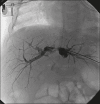The value of percutaneous transhepatic treatment of biliary strictures following pediatric liver transplantation
- PMID: 29085164
- PMCID: PMC5656071
- DOI: 10.1590/0100-3984.2016.0087
The value of percutaneous transhepatic treatment of biliary strictures following pediatric liver transplantation
Abstract
Objective: To evaluate the percutaneous transhepatic approach to the treatment of biliary strictures in pediatric patients undergoing liver transplantation.
Materials and methods: This was a retrospective study of data obtained from the medical records, laboratory reports, and imaging examination reports of pediatric liver transplant recipients who underwent percutaneous transhepatic cholangiography, because of clinical suspicion of biliary strictures, between 1st September 2012 and 31 May 2015. Data were collected for 12 patients, 7 of whom were found to have biliary strictures.
Results: In the 7 patients with biliary strictures, a total of 21 procedures were carried out: 2 patients (28.6%) underwent the procedure twice; 3 (42.8%) underwent the procedure three times; and 2 (28.6%) underwent the procedure four times. Therefore, the mean number of procedures per patient was 3 (range, 2-4), and the average interval between them was 2.9 months (range, 0.8-9.1 months). The drainage tube remained in place for a mean of 5.8 months (range, 3.1-12.6 months). One patient presented with a major complication, hemobilia, which was treated with endovascular embolization. Clinical success was achieved in all 7 patients, and the mean follow-up after drain removal was 15.4 months (range, 5.3-26.7 months).
Conclusion: The percutaneous transhepatic approach to treating biliary strictures in pediatric liver transplant recipients proved safe, with high rates of technical and clinical success, as well as a low rate of complications.
Objetivo: Demonstrar o valor da abordagem transparieto-hepática no tratamento de estenoses biliares em pacientes pediátricos submetidos a transplante de fígado.
Materiais e métodos: Estudo retrospectivo com revisão de prontuários, exames laboratoriais e de imagem dos pacientes pediátricos submetidos a transplante hepático. Foram incluídos pacientes com suspeita de estenose de vias biliares que realizaram colangiografia transparieto-hepática para diagnóstico, entre 1º de setembro de 2012 e 31 maio de 2015. Os dados de 12 pacientes foram coletados, dos quais 7 apresentaram estenose de vias biliares.
Resultados: No total foram realizados 21 procedimentos: 2 pacientes realizaram dois procedimentos (28,6%), 3 pacientes realizaram três procedimentos (42,8%) e 2 pacientes realizaram quatro procedimentos (28,6%). A média de procedimentos por paciente foi 3 (variação: 2–4) e o intervalo médio entre os procedimentos foi 2,9 meses (variação: 0,8–9,1 meses). A permanência média do dreno foi 5,8 meses (variação: 3,1–12,6 meses). Uma paciente apresentou hemobilia com instabilidade hemodinâmica, tratada com sucesso por via endovascular. O sucesso clínico foi alcançado nos 7 pacientes e o seguimento médio após retirada do dreno foi 15,4 meses (variação: 5,3–26,7 meses).
Conclusão: A abordagem transparieto-hepática das estenoses biliares em crianças submetidas a transplante de fígado demonstrou ser tratamento eficaz, com baixo índice de complicações.
Keywords: Biliary atresia; Cholangiography; Constriction, pathologic/therapy; Drainage; Liver transplantation.
Figures


References
-
- Otte JB. History of pediatric liver transplantation. Where are we coming from? Where do we stand? Pediatr Transplant. 2002;6:378–387. - PubMed
-
- Karakayali F, Kirnap M, Akdur A, et al. Biliary complications after pediatric liver transplantation. Transplant Proc. 2013;45:3524–3527. - PubMed
-
- Chok KS, Chan SC, Chan KL, et al. Bile duct anastomotic stricture after pediatric living donor liver transplantation. J Pediatr Surg. 2012;47:1399–1403. - PubMed
LinkOut - more resources
Full Text Sources
Other Literature Sources
